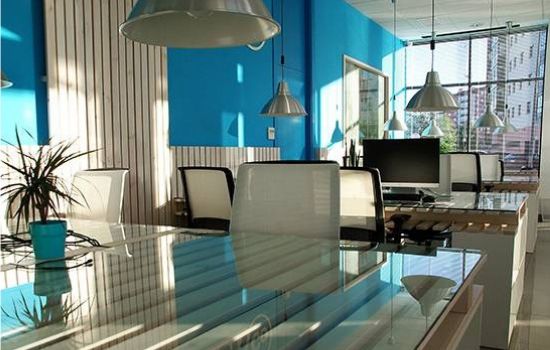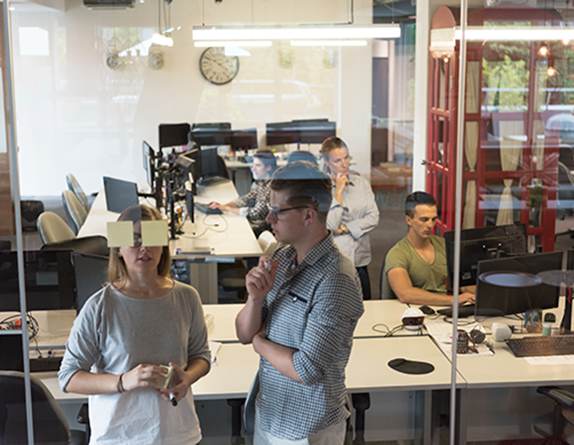- The nearly universal prevalence of mobile devices and mobile data usage
- The agile needs for less formal meeting spaces and the rapid growth of nimble meetings and informal team organization
- The evolution of meeting software
- The rise of collaborative technology – AV and video conferencing
- A new generation of worker, who embraces multi-tasking, digital technology and demands flexibility
- Talent retention – the need for a good working environment that promotes wellbeing and job satisfaction
- An increasingly competitive employment market, where the best workers can quickly move to better employment environments, and the perks of mobility and work life balance are critical to staff retention.
Today’s workplace has expanded to fill in the downtime on commutes, travel, and even an afternoon coffee.
As one major workplace real estate company said recently:
“No place or space is off limits in the world of flexible
work— especially for organizations embracing this trend
that is at the heart of the future of work.”
This should be the starting point for your journey on the road to workplace transformation, particularly if you’re in the fast-growing
service sector.
Start with building a workplace that allows your employees to be as nimble as the demands of your customer. Employees need to be able to work effectively wherever, whenever and however they choose to do it. That may sound simple but in practice workplace transformation is increasingly sophisticated.
This isn’t a matter of adjusting desk ratios. This transformation requires leveraging technology to make the complexity of an Shared Workspace appear easy.The best technology is the technology you forget is even working in the background to make your life easier. Multiply that impact across every single employee, and you can see why workplace transformation done right supercharges your team’s effectiveness. The same transformation done wrong can bring your team to a screeching halt. The core of this transformation is meeting software. The right software helps you make the most of the remote working revolution.
This allows you to give your entire team what they need to maximize effectiveness, better work life balance, flexibility in terms of how they work and a workplace that supports their work activities and personal lives.
- Do your people really need an office or permanent desk to work effectively?
- How do your employees engage? Do they use audio and video?
- If work is no longer 9 to 5, can you segment the day for different activities, including work tasks, social engagement and maybe even gym time?
- Could you make their work-life balance better with more desk booking from different locations including home?
- Is activity-based working an option? This structures the work location, the type of space used and the tool set required around the tasks being performed. It’s been shown to boost productivity.
The top companies in numerous industries have unlocked the full power of their teams by setting up the right space types and meeting software tools, then giving their staff the autonomy to make the right choices.
After all, if you can’t trust them to make those choices, how can you trust them with your business?
This enlightened approach also taps into a core human set of needs, enabling workers to make an important contribution and be a valued member of a team. Employees who can achieve valuable contribution stay longer, work harder and have better overall morale than those who are treated as cogs in a machine. Give them the tools and the agency to deliver and you will find that they do.
Begin by giving careful consideration to the work environment required for different elements of the activities you want your employees to carry out.
Choose meeting software that provides the support your remote employees need, particularly the new generations who are typically much more comfortable with technology. They expect flexibility in how they undertake work-related tasks and like informal styles of engagement.
Three key elements for delivering appropriate workplaces:
Let’s look at each of these elements in a little more detail.![]()
Sympathetic workplace design
![]()
The meeting software technology tool set
available to staff
![]()
Building infrastructure.
1. Workplace design
Modern workplaces are flexible spaces offering far more choices than the stodgy and bland offices of our parents.
They should include not just formal meeting spaces, but also collaboration spaces, informal hang out areas, different desk types based on functional need and high tech spaces with force multiplying technologies such as telepresence.
New build projects that link design with wellbeing and productivity are on the increase, but many companies are repurposing their existing spaces successfully.
The key is staying flexible and responding to needs – the forecast demand and actual utilization of different workspace often don’t turn out as originally assumed.
The difference between design and user experience is that user experience adapts to how people actually use the space. Be responsive and nimble, because the market demands it. This sort of flexibility sounds great, but it can be challenging to manage properly.

So what works well?
Our experience ( see these case studies ) suggests that to maximize the benefits of a well-designed workplace, you need three important elements:
- Good information on space and desk availability
- An easy ability to book the right workspace
- A clear set of operating rules accepted by the user community.
Here’s an example of how workplace transformation creates perfect meetings

Question:
James has to organize an important video conference, and needs his meeting to make a great impression.
His clients will join the meeting at James’ company office in Arizona, and James will be in New York. James’ sales director and finance director will join from another East Coast location.
It’s going to be a long meeting, so catering will be needed at each place.
How can James make sure the right meeting space is booked in each location, with the right VC equipment and catering arrangements in place?
What happens if one of the meeting details changes?

Answer:
James uses his meeting software system to select space and arrange all details in a single transaction, even the catering.
The system automatically books suitable space in different locations, checks that equipment is available, orders catering at the appropriate times and takes time zones into consideration. It’s all entered into Outlook by the system, which is fully integrated.
All involved in the meeting, including the people who set up the rooms, are automatically informed. If James needs to change any detail, automatic updates are sent to everyone to make sure they are aware.
This is just one example of how an intuitive meeting software booking system is the key to making effective use of high-cost/well-equipped space.

2. The technology toolset
This is a critical component that supports a more agile workforce and provides greater flexibility for staff to locate and use space around tasks being performed.
Technologies that integrate with meeting software and support workplace transformation include:
![]()
Digital signage
For information and engagement. One example is wayfinding, helping workers locate the right space or colleague
![]()
Mobile apps/portals
Offering self-service capability for staff on the move, eg a room or desk booking app
![]()
In-room technologies
Seamlessly connect meeting participants, saving time and creating meetings that work
![]()
Panels and other room
signage technologies
Ideally fully integrated with the in-room experience, for information purposes, including supporting service provision such as catering and AV
![]()
Sensor technologies
For real-time information on space and people, giving staff a fast route to locate what they need
![]()
Collaborative technologies
Connecting staff wherever they are.
More advanced technologies are also on the horizon, including AI and other automated tools for repetitive tasks, but because AI is still at an early stage and workplace metrics are only just being gathered, AI decision support should be seen as a future reality.

3. Building infrastructure
These days, everyone’s talking about the Smart Building. Critical elements of building infrastructure you should consider are:
IoT:
The internet of things will provide increasing amounts of useful data about how a building and its facilities are being utilized.
Greater integration of building controls and building systems – 68% of US respondents in a recent survey said they were planning to invest.

Energy efficiency/savings:
Globally, FM executives are planning to boost investment by 50%; it’s a major priority for many companies.
Because all of these innovations – and the management reports generated by meeting software – give great insight into the utilization of a building and its workspace, evolving building technology will make workplace transformation easier and more cost-effective to implement.
The key is to avoid the most costly transformation mistakes up front, and build a foundation that can continue to adapt as new technologies and social trends drive new ways of working. By using the right software, and creating the right work environment, your company can maximize the team you already have, and create the environment that will attract the top talent tomorrow.
Of course, you could always wait and see, but how much will that cost?
Make workspace transformation work for you. Discover how meeting software makes it happen here:
